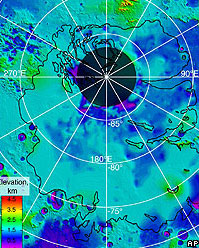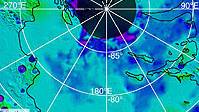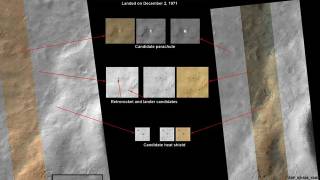'Cave entrances' spotted on Mars
Source: news.bbc.co.uk
 Scientists studying pictures from Nasa's Odyssey spacecraft have spotted what they think may be seven caves on the surface of Mars.
Scientists studying pictures from Nasa's Odyssey spacecraft have spotted what they think may be seven caves on the surface of Mars.The candidate caves are on the flanks of the Arsia Mons volcano and are of sufficient depth their floors mostly cannot be seen through the opening.
Details were presented here at the Lunar and Planetary Science Conference in Houston, Texas.
Temperature data from Mars Odyssey's Themis instrument support the idea.
The authors say that the possible discovery of caves on the Red Planet is significant.
The caves may be the only natural structures capable of protecting primitive life forms from micrometeoroids, UV radiation, solar flares and high energy particles that bombard the planet's surface.
The spacecraft spotted what seemed to be vertical "skylight" entrances to caves below the surface.
There is a sheer drop of between about 80m and 130m or more to the cave floors below.
'Seven sisters'
During the day, one of the features - nicknamed "Annie" - is warmer than surrounding pits and cooler than sunlit areas.
Night time temperatures are warmer than nearly all surrounding areas.
Co-author Glen Cushing, from the US Geological Survey in Flagstaff, Arizona, said this was exactly what would be expected if the feature were a cave.
"Nothing like these features has been seen elsewhere on Mars," he told BBC News.
The researchers describe the candidate caves as "seven sisters" and have given them all names: Dena, Chloe, Wendy, Annie, Abbey, Nicki and Jeanne.
The cave entrances are between 100m and 252m wide (330-828ft).
Because in most cases the cave floors cannot be seen, only minimum depths are known: the researchers calculated they must extend between 73m and 96m (240-315ft) below the surface.
However, in one image taken of Dena by the Mars Odyssey Camera, a floor can be seen.
Using the data, the authors calculated that this cave must extend 130m (426ft) below the surface.
Mars Odyssey was launched in April 2001 to hunt for past or present water on the Red Planet.
Its Themis (Thermal Emission Imaging System) instrument uses the visible and infrared part of the electromagnetic spectrum to measure the temperature properties of the Martian surface.
Article from: http://news.bbc.co.uk/2/hi/science/nature/6461201.stm






















